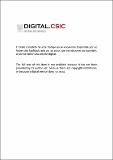Por favor, use este identificador para citar o enlazar a este item:
http://hdl.handle.net/10261/309847COMPARTIR / EXPORTAR:
 SHARE SHARE
 CORE
BASE CORE
BASE
|
|
| Visualizar otros formatos: MARC | Dublin Core | RDF | ORE | MODS | METS | DIDL | DATACITE | |

| Título: | Recovery and Community Succession of the Zostera marina Rhizobiome after Transplantation |
Autor: | Wang, Lu; English, Mary K.; Tomàs, Fiona CSIC ORCID; Mueller, Ryan S. | Palabras clave: | Eelgrass Microbial diversity Restoration Rhizoplane Rhizosphere Seagrass Succession |
Fecha de publicación: | 15-ene-2021 | Editor: | American Society for Microbiology | Citación: | Applied and Environmental Microbiology 87(3): 02326-20 (2020) | Resumen: | Seagrasses can form mutualisms with their microbiomes that facilitate the exchange of energy sources, nutrients, and hormones and ultimately impact plant stress resistance. Little is known about community succession within the belowground seagrass microbiome after disturbance and its potential role in the plant's recovery after transplantation. We transplanted Zostera marina shoots with and without an intact rhizosphere and cultivated plants for 4 weeks while characterizing microbiome recovery and effects on plant traits. Rhizosphere and root microbiomes were compositionally distinct, likely representing discrete microbial niches. Furthermore, microbiomes of washed transplants were initially different from those of sod transplants and recovered to resemble an undisturbed state within 14 days. Conspicuously, changes in the microbial communities of washed transplants corresponded with changes in the rhizosphere sediment mass and root biomass, highlighting the strength and responsive nature of the relationship between plants, their microbiome, and the environment. Potential mutualistic microbes that were enriched over time include those that function in the cycling and turnover of sulfur, nitrogen, and plant-derived carbon in the rhizosphere environment. These findings highlight the importance and resilience of the seagrass microbiome after disturbance. Consideration of the microbiome will have meaningful implications for habitat restoration practices.IMPORTANCE Seagrasses are important coastal species that are declining globally, and transplantation can be used to combat these declines. However, the bacterial communities associated with seagrass rhizospheres and roots (the microbiome) are often disturbed or removed completely prior to transplantation. The seagrass microbiome benefits seagrasses through metabolite, nutrient, and phytohormone exchange and contributes to the ecosystem services of seagrass meadows by cycling sulfur, nitrogen, and carbon. This experiment aimed to characterize the importance and resilience of the seagrass belowground microbiome by transplanting Zostera marina with and without intact rhizospheres and tracking microbiome and plant morphological recovery over 4 weeks. We found the seagrass microbiome to be resilient to transplantation disturbance, recovering after 14 days. Additionally, microbiome recovery was linked with seagrass morphology, coinciding with increases in the rhizosphere sediment mass and root biomass. The results of this study can be used to include microbiome responses in informing future restoration work. | Versión del editor: | https://doi.org/10.1128/AEM.02326-20 | URI: | http://hdl.handle.net/10261/309847 | DOI: | 10.1128/AEM.02326-20 | ISSN: | 0099-2240 | E-ISSN: | 1098-5336 |
| Aparece en las colecciones: | (IMEDEA) Artículos |
Ficheros en este ítem:
| Fichero | Descripción | Tamaño | Formato | |
|---|---|---|---|---|
| Acceso_restringido.pdf | 108,79 kB | Adobe PDF |  Visualizar/Abrir |
CORE Recommender
PubMed Central
Citations
4
checked on 05-abr-2024
SCOPUSTM
Citations
11
checked on 16-may-2024
WEB OF SCIENCETM
Citations
10
checked on 25-feb-2024
Page view(s)
31
checked on 16-may-2024
Download(s)
14
checked on 16-may-2024
Google ScholarTM
Check
Altmetric
Altmetric
Artículos relacionados:
NOTA: Los ítems de Digital.CSIC están protegidos por copyright, con todos los derechos reservados, a menos que se indique lo contrario.
